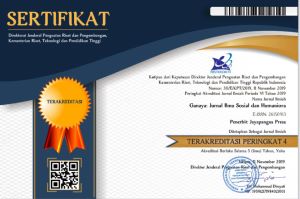Etnomatematika: Eksplorasi Konsep Geometri di Sekolah Dasar dalam Kearifan Lokal kain Songket dan Pakaian Melayu
DOI:
https://doi.org/10.37329/ganaya.v8i2.4192Keywords:
Ethnomathematics, Geometry, Songket Cloth, Malay Clothing, Mathematics LearningAbstract
Mathematics learning in elementary schools is often considered abstract and detached from the context of everyday life. Findings in the field, the low ability of students to understand concepts and the lack of knowledge related to culture are the main problems that need to be solved. One alternative approach used to bridge this gap is ethnomathematics, namely by linking mathematical concepts with local culture. This study aims to explore the integration of geometric concepts in the local wisdom of songket cloth and Malay clothing in mathematics learning in elementary schools. The research method used is qualitative with an ethnographic approach. Data were collected through participatory observation, interviews and visual documentation of the motifs and structures of traditional clothing such as teluk belanga, cekak musang and kekek. The results showed that motifs such as pucuk rebung, siku keluang, and bunga cengkih reflect geometric concepts such as symmetry, reflection, rotation, and translation. In addition, elements of Malay clothing reflect the forms of flat and spatial shapes, which can be used to teach the concepts of area and volume. This integration not only enriches the learning material, but also increases students' interest and motivation to learn because the material is presented through a cultural approach that is close to their lives. The conclusion of this study is that the ethnomathematics approach based on local culture has great potential in improving students' conceptual understanding of geometry while preserving cultural heritage.
References
Ahmad, A. (2025). Integrasi Budaya Dalam Pembelajaran Matematika: Studi Kasus Pada Sekolah Dasar. Jurnal Pendidikan Matematika dan Budaya, 12(1), 45–60.
Barton, B. (2020). Cultural Ways of Knowing and Learning Mathematics. Cambridge University Press.
Bima, A., & Sugeng, B. (2018). Penggunaan Media Visual Dalam Pembelajaran Matematika Untuk Meningkatkan Pemahaman Konsep Siswa Sekolah Dasar. Jurnal Pendidikan Matematika, 12(1), 45–52.
D’Ambrosio, U. (2016). Ethnomathematics and Its Implications for Mathematics Education. Cham: Springer.
Handayani, R., & Mahrita, S. (2021). Pendekatan Kontekstual Dalam Pembelajaran Matematika Di Sekolah Dasar. Jurnal Pendidikan Dasar Indonesia, 9(2), 78–92.
Johnson, M. (2022). The Impact Of Culturally Responsive Teaching In Elementary Mathematics Education. International Journal of Mathematics Education, 15(3), 112–130.
Kemendikbudristek. (2023). Laporan Hasil Asesmen Nasional 2023. Kementerian Pendidikan, Kebudayaan, Riset, dan Teknologi Republik Indonesia.
NCTM. (2020). Principles To Actions: Ensuring Mathematical Success For All. VA: National Council of Teachers of Mathematics.
Novita, R. (2019). Integrasi Konteks Budaya Dalam Pembelajaran Geometri Untuk Meningkatkan Pemahaman Konsep Transformasi. Jurnal Pendidikan dan Kebudayaan, 24(2), 115–124.
Pang, J. S. (2012). Mathematical Thinking And Problem Solving Through Symmetry Activities In Elementary School. Journal of Mathematical Behavior, 31(3), 309–323.
Piaget, J. (2023). The Psychology of Intelligence. Abingdon: Routledge.
Putri, D. A. (2023). Pengembangan Media Pembelajaran Berbasis Budaya Lokal Untuk Meningkatkan Pemahaman Konsep Matematika. Jurnal Inovasi Pendidikan Dasar, 6(1), 23–35.
Ramadhani, F., Syahputra, R., & Nasution, M. A. (2024). Pengembangan Bahan Ajar Berbasis Budaya Lokal Dalam Pembelajaran Matematika. Jurnal Matematika dan Pendidikan, 13(2), 100–115.
Rosa, M., & Orey, D. C. (2021). Ethnomathematics and Diverse Cultural Perspectives in Mathematics Education. Cham: Springer
Rosiana, Y., & Kartini, T. (2016). Pengaruh Pembelajaran Berbasis Etnomatematika Terhadap Motivasi Belajar Dan Hasil Belajar Siswa. Jurnal Pendidikan Matematika, 10(2), 83–91.
Santosa, M. I., & Surya, E. (2017). Pengaruh Model Pembelajaran Kontekstual Berbasis Budaya Lokal Terhadap Hasil Belajar Matematika Siswa. Jurnal Education And Development, 5(3), 10–18.
Setiawan, I. (2018). Pembelajaran Geometri Melalui Desain Motif Batik Sebagai Upaya Meningkatkan Kreativitas Siswa. Jurnal Kreano, 9(1), 52–60.
Sharma, S., & Orey, D. C. (2017). Ethnomathematics And Its Role In Culturally Relevant Pedagogy. Educational Studies in Mathematics, 96(1), 1–20.
Simamora, R. E. (2020). Penerapan Pembelajaran Kontekstual Untuk Meningkatkan Kemampuan Menghitung Luas Dan Keliling Bangun Datar Siswa SD. Jurnal Cendekia: Jurnal Pendidikan Matematika, 4(1), 12–21.
Soedjadi, R., & Ramadhan, S. (2019). Pembelajaran Matematika Yang Kontekstual Dan Bermakna: Teori Dan Aplikasi. Jakarta: Universitas Terbuka Press.
Suryanto, A. (2021). Integrasi Motif Budaya Dalam Pembelajaran Matematika Sekolah Dasar. Jurnal Pendidikan Matematika, 5(2), 88–97.
Suwarsono, S. (2014). Pengantar Berpikir Matematik: Proses dan strategi. Jakarta: Universitas Terbuka.
UNESCO. (2025). Cultural Heritage And Education: Integrating Traditional Knowledge In Modern Learning Systems. UNESCO Publishing.
Yusuf, R. (2024). Pendidikan Berbasis Budaya Dalam Pembelajaran Matematika: Studi Di Sekolah Dasar. Jurnal Pendidikan Multikultural, 7(2), 34–50.
Downloads
Published
How to Cite
Issue
Section
License
Copyright (c) 2025 Siti Quratul Ain, Leny Julia Lingga, Nesa Sakila, Windi Yoanda (Author)

This work is licensed under a Creative Commons Attribution-ShareAlike 4.0 International License.
An author who publishes in the Ganaya : Jurnal Ilmu Sosial dan Humaniora agrees to the following terms:
- Author retains the copyright and grants the journal the right of first publication of the work simultaneously licensed under the Creative Commons Attribution-ShareAlike 4.0 License that allows others to share the work with an acknowledgement of the work's authorship and initial publication in this journal
- Author is able to enter into separate, additional contractual arrangements for the non-exclusive distribution of the journal's published version of the work (e.g., post it to an institutional repository or publish it in a book) with the acknowledgement of its initial publication in this journal.
- Author is permitted and encouraged to post his/her work online (e.g., in institutional repositories or on their website) prior to and during the submission process, as it can lead to productive exchanges, as well as earlier and greater citation of the published work (See The Effect of Open Access).
Read more about the Creative Commons Attribution-ShareAlike 4.0 Licence here: https://creativecommons.org/licenses/by-sa/4.0/.








